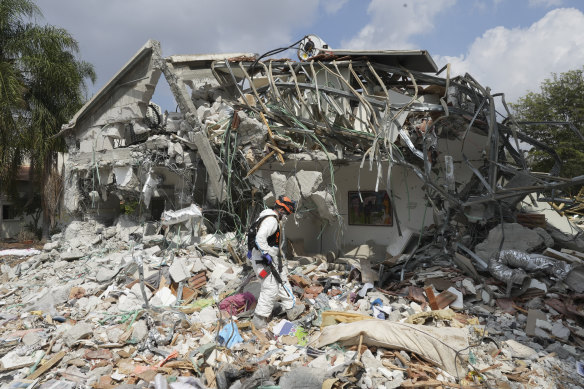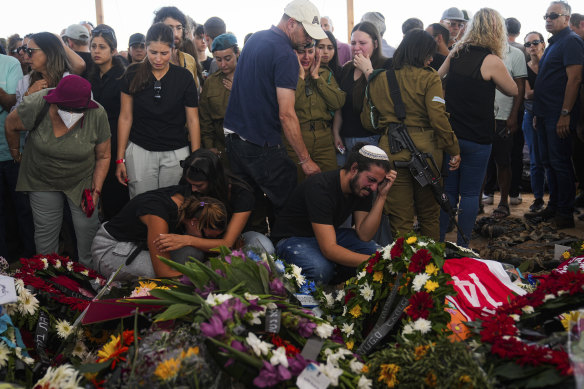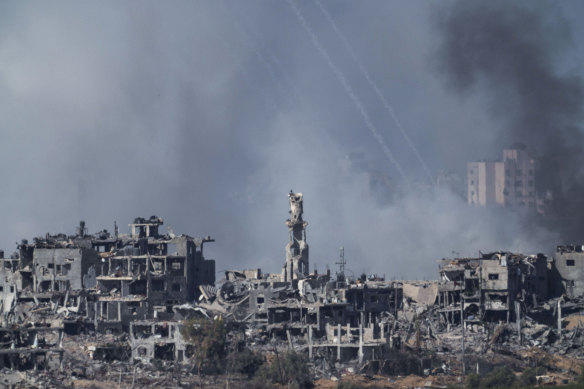Save articles for later
Add articles to your saved list and come back to them any time.
Israel revised its official estimated death toll of the October 7 Hamas attacks, lowering the number to about 1200 people, down from the more than 1400 initially cited, a spokesperson for the country’s Foreign Ministry said last Friday.
The spokesperson, Lior Haiat, said the original figure was an “initial estimate” that had now been updated. He declined to provide further details on the change but emphasised that the numbers could continue to fluctuate as the remains of those killed are identified.
An Israeli soldier walks past a house destroyed by Hamas militants in Be’eri kibbutz, Israel.Credit: AP
For both Israelis and Palestinians, the casualty counts in the month-long war between Israel and Hamas have become emotionally charged figures. The tolls have become symbols for the depth of the agony gripping both peoples, and partisans on either side have sought to play down the number of those killed on the opposite camp.
Here what we know about the death toll in Israel from the October 7 attacks.
How many people were killed in Israel during the October 7 attacks?
On October 7, scores of Hamas gunmen swept into Israeli towns and military bases near the border with the Gaza Strip, opening fire on people in their homes, on the streets and at a music festival. The attackers fatally shot the elderly, women and young children, according to survivors; others were burned after attackers set their homes ablaze.
The vast majority of those killed in the October 7 assault — about 70 per cent — have been identified as civilians, not soldiers, by Israeli authorities. According to Israeli police, health officials have identified at least 846 civilians killed in the fighting.
At least 278 soldiers were killed in the battles inside Israel, according to the Israeli military’s website, and at least 44 police officers died in the fighting, Israeli police said in mid-October. (Additionally, at least 46 Israeli soldiers have been killed since the ground invasion of Gaza began at the end of the month.)
Those killed in Israel on October 7 also included foreigners and dual nationals. At least 31 US citizens and 39 French citizens were killed during the attacks, authorities in both countries have said. Other victims included at least 34 Thai nationals; Asian workers were a common sight in the farms near Israel’s border with Gaza.
Mourners at the funeral of the Kotz family in Gan Yavne, Israel, after the family of five was killed by Hamas militants last month.Credit: AP
Why did Israel’s figures change?
Israel’s original estimated toll from the attacks was subject to less scrutiny than the death toll compiled by the Hamas-controlled authorities in Gaza, where thousands have died in weeks of heavy Israeli bombardment and a ground invasion.
Some news outlets — including The New York Times — occasionally used those Israeli figures without attributing them to Israeli officials or noting that they were an initial estimate and subject to change.
One reason for the fluctuating death toll is that Israeli health officials say they have struggled to identify many Israelis and foreigners killed in the attacks, and they excluded from the official toll the remains of those they considered to have been attackers, highlighting the complicated task of giving an accurate, authoritative count.
The Palestinian attackers burned or otherwise mutilated many of the corpses, requiring extensive testing to establish their identities, according to officials at Israel’s main forensic institute. Other victims were foreign nationals who did not have immediate family around to help identify their remains, the officials said.
Destroyed furniture and charred walls are seen in a Kibbutz Nir Oz home that came under attack by Hamas on October 7.Credit: AP
According to Israeli Foreign Ministry officials, some of the Hamas-led militants wore Israeli military uniforms or civilian clothing, creating confusion about their identities. Some body parts that have been found have not yet been linked to corpses.
As a result of such complications, officials say it may take weeks to finalise the precise number of how many were killed in the initial attack.
The Israeli soldiers killed were far easier to identify than their civilian counterparts, according to Israeli health officials: Recruits routinely turn over their genetic material to the military when they are conscripted in order to ensure they can be identified in the event they are killed.
Could the Israeli toll for the attacks change again?
With most of the bodies of those killed in the Hamas-led attack now having been definitively identified, another major reduction in the death toll is unlikely. But the figure could incrementally rise as forensic pathologists slowly work their way through the remaining missing and dead.
Another factor that could change Israeli authorities’ estimate involves the roughly 239 people abducted October 7 and believed to be held by Hamas and other Palestinian armed groups in Gaza. The Israeli military has said most of the hostages are alive, but that militants also took some corpses back with them into Gaza. If the identities of those corpses are confirmed, that could drive the toll upward as well.
What about the death toll in Gaza?
According to the Palestinian Ministry of Health in Hamas-controlled Gaza, Israeli strikes have killed more than 11,000 people in the territory since the war broke out. The tally did not distinguish between militants and civilians. At least 4,506 were minors and 3,027 were women, according to the ministry.
The Gaza death toll has been subject to debate among US and Israeli officials. Some, including US President Joe Biden, have cast doubt on the figures from health officials in Gaza given Hamas’ control over the territory.
Thousands of Palestinians have been killed by Israeli airstrikes on the Gaza Strip.Credit: AP
But in recent days, several top Biden administration officials have acknowledged that thousands of Palestinian civilians have been killed since Israel’s bombardment began. They have declined to offer their own estimates, saying they are unable to verify the data provided by Gaza’s health ministry.
On Tuesday, John Kirby, US national security spokesperson, told reporters: “There have been many thousands killed.” And on Wednesday, Barbara Leaf, Assistant Secretary of State for Near Eastern Affairs, told a House committee that the civilian death toll in Gaza could be even higher than the numbers that the authorities in Gaza have released.
The United Nations, rights groups and aid organisations have continued to cite the ministry, while also saying that they cannot independently confirm its figures. But they say the ministry’s death tolls have been found to be consistent with their own investigations after past conflicts, and a U.S. State Department report this year cited the ministry’s figures.
This article originally appeared in The New York Times.
Most Viewed in World
From our partners
Source: Read Full Article






